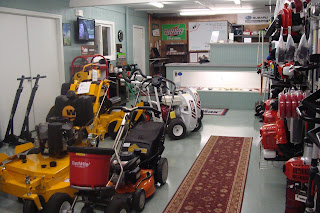One of the best ways to keep a lawn healthy is by aerating it. Unfortunately, because aeration is not always understood, the benefits of this practice can be missed. Just like organisms benefit from the movement of nutrients and removal of waste, so does the ecosystem of a grass lawn. Over time soil compaction often occurs, frequently as the result of traffic. And, when this happens, there isn’t enough room in soil for water and air to circulate. Core aeration, the most effective type of aeration, reverses the effects of this compressing of soil by removing small cylinders of earth. Here are five tips for aerating a lawn.
1. Pick the right time of year for your aeration to have maximum effect.
Aerating at the right point in time depends on the type of grass you have on your lawn. If you live in a climate where cool season grasses (like bluegrasses, fescues, ryes) are planted, then you’ll want to aerate in late summer or in the fall, when these grasses have weathered the worst summer heat and are growing with a steady supply of moisture. If you are using warm season grasses (like zoysia grasses or bermuda grasses), then aeration is best during the late spring or early summer. Again, this is the time these grasses are growing most steadily.
2. Frequency of aeration depends upon lawn traffic and on need.
Aeration is typically not a normally scheduled event for a private lawn. The real question is how often will people, animals, or vehicles be crossing the grass, thus causing compaction. This may mean that certain, more used parts of a lawn may need to be aerated more often.
3. Before aerating, appropriately irrigate the lawn.
If the soil is wet, you won’t want to aerate it, as it can get quite muddy. However, you also want to make sure the soil isn’t too dry either. It is typically suggested that you water a dry lawn between two days before and the evening before you aerate to ensure that the soil isn’t rock hard.
4. Aeration doesn’t have to be costly.
Especially, if you have a smaller lawn, you can aerate it yourself. While not as effective as a core aerator, some people just use a spading fork to plunge holes into the soil. Buying or renting a coring aerator is another way to go. If you do buy one, it can be a good idea to go in on it with a friend, as neither of you will use be using it nearly as often as a mower or other lawn equipment.
5. Make the most of aerating by pairing it with other means of lawn care.
Right after aerating is an ideal time to apply fertilizer to a lawn, allowing it to really reach the grass roots. It is also good to re-seed a lawn after aeration. The challenge here is to first try to get rid of the cored pieces of soil sitting on the lawn as seeds may grow in these, leading to uneven growth. Either raking these cores up or else waiting for rain to wash them away will prevent this.
In addition to aerating a lawn, remember that cutting the grass well also contribute to the health of the lawn.
.jpg)














